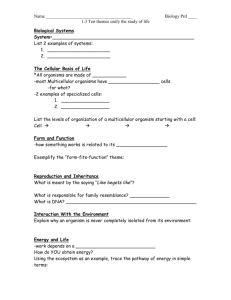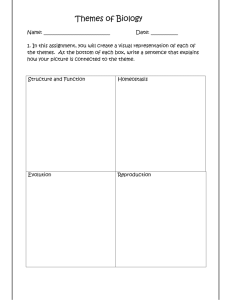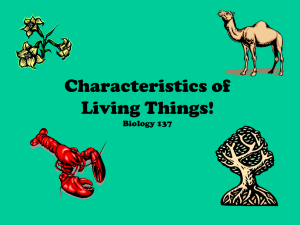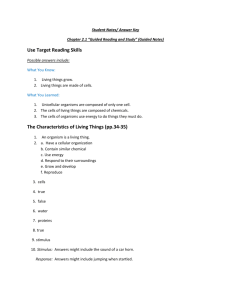Unit 1 Vodcast 1.3
advertisement
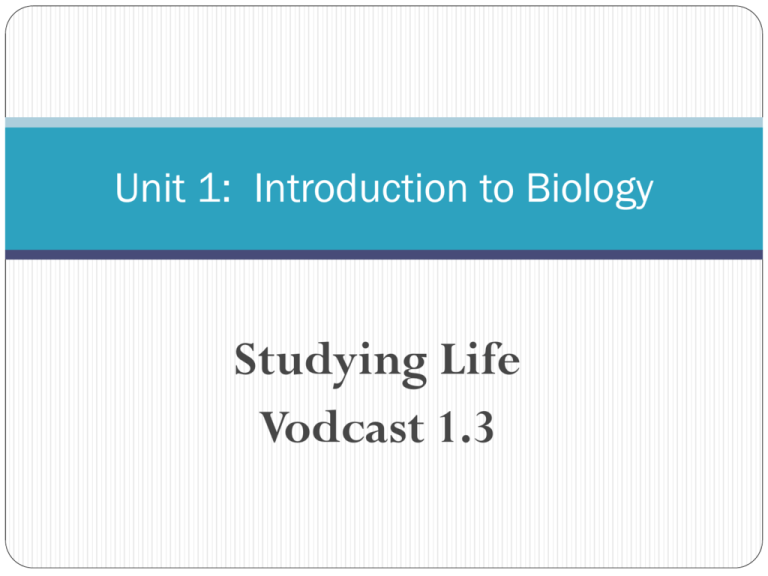
Unit 1: Introduction to Biology Studying Life Vodcast 1.3 What is Biology? Biology – the study of life Biology is the science that seeks to understand the living world What Characteristics Do All Living Things Share? Living things are made up of cells Cells are the basic unit of life Organisms are composed of one or more cells – the smallest units considered alive Despite their small size, cells are complex and highly organized Living things are based on a universal genetic code All organisms store the complex information they need to live, grow, and reproduce in a genetic code written in a molecule call DNA That information is copied and passed from parent to offspring Living things obtain and use materials and energy All organisms must take in materials and energy to grow, develop, and reproduce Metabolism – the combination of chemical reactions through which an organism builds up or breaks down materials Characteristics of Living Things Continued… Living things grow and develop Every organism has a particular pattern of growth and development During development, cells divide and differentiate (they begin to look different from one another and perform different functions) Living things reproduce All organisms reproduce, which means that they produce new similar organisms Sexual reproduction – cells from two parents unite to form the first cell of a new organism Asexual reproduction – a single organism produces offspring identical to itself Characteristics of Living Things Continued… Living things respond to their environment Organism detect and respond to stimuli from their environment Stimulus – a signal to which an organism responds Living things maintain a stable internal environment All organisms need to keep their internal environment relatively stable, even when external conditions change dramatically Homeostasis – relatively constant internal physical and chemical conditions that an organism maintains Taken as a group, living things evolve Over generations, evolution (change over time) occurs to groups of organisms Evolutionary change links all forms of life to a common origin more than 3.5 billion years ago What Are the Central Themes of Biology? The study of Biology revolves around several interlocking big ideas: Cellular Basis of Life Living things are made up of cells Unicellular – single-celled Multicellular – consisting of two or more cells Information and Heredity Living things are based on a universal genetic code – DNA Matter and Energy Living things obtain and use materials and energy Life requires matter that serves as nutrients to build body structures, and energy that fuels life’s processes The need for matter and energy link all living things on Earth in a web of interdependent relationships Central Themes in Biology Continued… Growth, Development, and Reproduction All living things reproduce During growth and development, generalized cells typically become more and more different and specialized for particular functions Homeostasis Living things maintain a relatively stable internal environment, a process known as homeostasis For most organisms, any breakdown of homeostasis may have serious or even fatal consequences Evolution Taken as a group, living things evolve Evolutionary theory is the central organizing principle of all biological and biomedical science Central Themes in Biology Continued… Structure and Function Structures have evolved in ways that make particular functions possible Unity and Diversity of Life Although life takes an almost unbelievable variety of forms, all living things are fundamentally similar at the molecular level One great contribution of evolutionary theory is that it explains both the is unity of life and its diversity Interdependence in Nature All forms of life on Earth are connected into a biosphere – “living planet” Within the biosphere, organisms are linked to one another and to the land, water, and air around them Relationships between organism and their environments depend on the cycling of matter and the flow of energy Central Themes in Biology Continued… Science as a Way of Knowing Science is not a list of facts, but “a way of knowing” The job of scientists is to use observations, questions, and experiments to explain the natural world in terms of natural forces and events Successful scientific research reveals rules and patterns that can explain and predict at least some events in nature Science allows us to take actions that affects events in the world around us What are the levels of biological organization? 1 2 8 7 6 3 10 9 12 5 4 11 Levels of Biological Organization Atoms – basic unit of matter (ex: C, H, N, O) Organelles – the various functional components present in a cell (ex: mitochondria, chloroplast) Molecules – a chemical structure consisting of two or more atoms (ex: DNA, water) Cells – basic unit of life - the structural and functional unit of all living things (ex: plant cell, animal cell) Levels of Biological Organization Organs – a body part made up of a group of tissues that carries out a particular function in the body (ex: the brain, leaves) Tissues – made up of a group of cells that work together, performing a specialized function (ex: epidermal tissue, nervous tissue) Organ Systems – a team of organs that cooperate in a larger function (ex: nervous system, digestive system) Levels of Biological Organization Population – all the individuals of a species living within the bounds of a specific area Organism – individual living thing (ex: elephant, tree) Community – the entire array of organisms inhabiting a particular ecosystem Levels of Biological Organization Biosphere – consists of all life on Earth and all the places where life exists – all of Earth’s ecosystems combined Ecosystem – consists of all the living (biotic) things in a particular area along with all the nonliving (abiotic) components of the environment with which life interacts How Do Different Fields of Biology Differ in Their Approach to Studying Life? Biology includes many overlapping fields that use different tools to study life from the level of molecules to the entire planet




